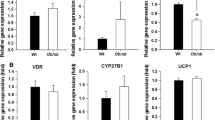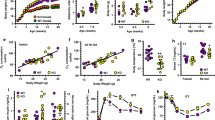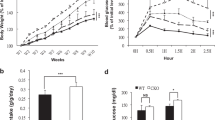Abstract
Background/Aims: Retinoic acid (RA), the carboxylic acid form of vitamin A, through the activation of cognate receptors, stimulates the transcription of the gene encoding uncoupling protein 1 (UCP1), which is critical to brown adipose tissue (BAT) thermogenesis. RA was previously shown to down-regulate the steady state levels of retinoic acid receptor α (RARα) and retinoid X receptor α (RXRα) in primary brown adipocytes differentiated in culture. Our aim was to study the impact of RA-treatment and vitamin A status on the expression levels of these receptors in vivo. Methods: Three-week-old mice were fed standard chow or a vitamin A deficient diet for 10 weeks, after which animals on both diets were treated with all-trans RA (ATRA, 100 mg·Kg−1·day−1) or vehicle during 4 days. Levels of UCP1, RARα and RXRα in BAT were determined by immunoblotting. Results: ATRA-treatment resulted in a reduction of the specific RARα and especially RXRα content in BAT that paralleled the induction of UCP1 appearance in the tissue. RARα and RXRα levels per gram of BAT were reduced in mice chronically fed the vitamin A-deficient diet. Conclusion: RA modulates the expression of cognate receptors in BAT, suggesting auto regulation of the retinoid effect on the thermogenic system (Mol Cell Biochem 266: 25–30, 2004)
Similar content being viewed by others
References
Lowell BB, Spiegelman BM: Towards a molecular understanding of adaptive thermogenesis. Nature 404: 652–660, 2000
Palou A, Serra F, Bonet ML, Pico C: Obesity: Molecular bases of a multifactorial problem. Eur J Nutr 39: 127–144, 2000
Palou A, Picó C, Bonet ML, Oliver P: The uncoupling protein, thermogenin. Int J Bichem Cell Biol 30: 7–11, 1998
Nedergaard J, Golozoubova V, Matthias A, Asadi A, Jacobsson A, Cannon B: UCP1: The only protein able to mediate adaptative non-shivering thermogenesis and metabolic inefficiency. Biochim Biophys Acta 1504: 82–106, 2001
Cassard-Doulcier AM, Larose M, Matamala JC, Champigny O, Bouillaud F, Ricquier D: In vitro interaction between nuclear protein and uncoupling protein gene promoter reveal several putative transactivating factors including Ets1, retinoid X receptor, thyroid hormone receptor, and a CCAAT box-binding protein. J Biol Chem 269: 24335–24342, 1994
Alvarez R, De Andrés J, Yubero P, Viñas O, Mampel T, Iglesias R, Giralt M, Villarroya F: Anovel regulatory pathway of brownfat thermogenesis. Retinoic acid is a transcriptional activator of mitochondrial uncoupling protein gene. J Biol Chem 270: 5666–5673, 1995
Puigserver P, Vázquez F, Bonet ML, Picó C, Palou A: In vitro and in vivo induction of brown adipocyte uncoupling protein (thermogenin) by retinoic acid. Biochem J 317: 827–833, 1996
Kumar MV, Scarpace PJ: Differential effects of retinoic acid on uncoupling protein-1 and leptin gene expression. J Endocrinol 157: 237–243, 1998
Serra F, Bonet ML, Puigserver P, Oliver J, Palou A: Stimulation of uncoupling protein 1 expression in brown adipocytes by naturally occurring carotenoids. Int J Obes Relat Metab Disord 23: 650–655, 1999
Kumar MV, Sunvold GD, Scarpace PJ: Dietary vitamin A supplementation in rats: Suppression of leptin and induction of UCP1 mRNA. J Lipid Res 40: 824–829, 1999
Bonet ML, Oliver J, Picó C, Felipe F, Ribot J, Cinti S, Palou A: Opposite effects of vitamin Adeficient diet-feeding and retinoic acid treatment on brown adipose tissue UCP1, UCP2 and leptin expression. J Endocrinol 166: 511–517, 2000
Carmona MC, Valmaseda A, Iglesias R, Mampel T, Vinas O, Giralt M, Villarroya F: 9-cis retinoic acid induces the expression of the uncoupling protein-2 gene in brown adipocytes. FEBS Lett 441: 447–450, 1998
Hatakeyama Y, Scarpace PJ: Transcriptional regulation of uncoupling protein-2 gene expression in L6 myotubes. Int J Obes Relat Metab Disord 25: 1619–1624, 2001
Solanes G, Pedraza N, Iglesias R, Giralt M, Villarroya F: The human uncoupling protein-3 gene promoter requires MyoD and is induced by retinoic acid in muscle cells. FASEB J 14: 2141–2143, 2000
Felipe F, Bonet ML, Ribot J, Palou A: Upregulation of muscle uncoupling protein 3 gene expression in mice following high fat diet, dietary vitamin A supplementation and acute retinoic acid-treatment. Int J Obes Relat Metab Disord 27: 60–69, 2003
Ribot J, Felipe F, Bonet ML, Palou A: Changes of adiposity in response to vitamin Astatus correlate with changes of PPARgamma 2 expression. Obes Res 9: 500–509, 2001
Felipe F, Bonet ML, Ribot J, Palou A: Modulation of resistin expression by retinoic acid and vitamin A status. Diabetes 53: 882–889, 2004
Villarroya F, Giralt M, Iglesias R: Retinoids and adipose tissues: metabolism, cell differentiation and gene expression. Int J Obes Relat Metab Disord 23: 1–6, 1999
Bonet ML, Ribot J, Felipe E, Palou A: Vitamin A and the regulation of fat reserves. Cell Mol Life Sci 60: 1311–1321, 2003
Chambon P: A decade of molecular biology of retinoic acid receptors. FASEB J 10: 940–954, 1996
Mukherjee R, Davies PJ, Crombie DL, Bischoff ED, Cesario RM, Jow L, Hamann LG, Boehm MF, Mondon CE, Nadzan AM, Paterniti JR, Jr., Heyman RA: Sensitization of diabetic and obese mice to insulin by retinoid X receptor agonists. Nature 386: 407–410, 1997
Rabelo R, Reyes C, Schifman A, Silva E: A complex retinoic acid response element in the uncoupling protein gene defines a novel role for retinoids in thermogenesis. Endocrinology 137: 3488–3496, 1996
Larose M, Cassard-Doulcier AM, Fleury C, Serra F, Champigny O, Bouillaud F, Ricquier D: Essential cisacting elements in rat uncoupling protein gene are in an enhancer containing a complex retinoic acid response domain. J Biol Chem 271: 31533–31542, 1996
Alvarez R, Checa ML, Brun S, Viñas O, Mampel T, Iglesias R, Giralt M, Villarroya F: Both retinoic-acid-receptor and retinoid-X-receptor-dependent signaling pathways mediate the induction of the brown-adipose-tissue-uncoupling-protein-1 gene by retinoids. Biochem J 345: 91–97, 2000
Sears IB, MacGinnitie MA, Kovacs LG, Graves RA: Differentiation-dependent expression of the brown adipocyte uncoupling protein gene: regulation by peroxisome proliferator-activated receptor gamma. Mol Cell Biol 16: 3410–3419, 1996
Bonet ML, Puigserver P, Serra F, Ribot J, Vazquez F, Pico C, Palou A: Retinoic acid modulates retinoid X receptor alpha and retinoic acid receptor alpha levels of cultured brown adipocytes. FEBS Lett 406: 196–200, 1997
Wharton DC, Tzagollof A: Cytochrome oxidase from beef heart mitochondria. Methods Enzymol 10: 245–246, 1967
Bradford MM: A rapid and sensitive method for the quantitation of microgram quantities of protein utilizing the principle of protein-dye binding. Anal Biochem 72: 248–254, 1976
Puigserver P, Llado I, Palou A, Gianotti M: Evidence for masking of brown adipose tissue mitochondrial GDP-binding sites in response to fasting in rats made obese by dietary manipulation. Effects of reversion to standard diet. Biochem J 279: 575–579, 1991
Rochette-Egly C, Lutz Y, Pfister V, Heyberger S, Scheuer I, Chambon P, Gaub MP: Detection of retinoid X receptors using specific monoclonal and polyclonal antibodies. Biochem Biophys Res Commun 204: 525–536, 1994
Gaub MP, Rochette-Egly C, Lutz Y, Ali S, Matthes H, Scheuer I, Chambon P: Immunodetection of multiple species of retinoic acid receptor alpha: Evidence for phosphorylation. Exp Cell Res 201: 335–346, 1992
Kawada T, Kamei Y, Sugimoto E: The possibility of active form of vitamin A and D as supressors on adipocyte development via ligand-dependent transcriptional regulators. Int J Obes Relat Metab Disord 20: S52–S57, 1996
de The H, Marchio A, Tiollais P, Dejean A: Differential expression and ligand regulation of the retinoic acid receptor alpha and beta genes. EMBO J 8: 429–433, 1989
Hu L, Gudas LJ: Cyclic AMP analogs and retinoic acid influence the expression of retinoic acid receptor alpha, beta, and gamma mRNAs in F9 teratocarcinoma cells. Mol Cell Biol 10: 391–396, 1990
Martin CA, Ziegler LM, Napoli JL: Retinoic acid, dibutyryl-cAMP, and differentiation affect the expression of retinoic acid receptors in F9 cells. Proc Natl Acad Sci USA 87: 4804–4808, 1990
Leroy P, Krust A, Zelent A, Mendelsohn C, Garnier JM, Kastner P, Dierich A, Chambon P: Multiple isoforms of the mouse retinoic acid receptor alpha are generated by alternative splicing and differential induction by retinoic acid. EMBO J 10: 59–69, 1991
Haq R, Pfahl M, Chytil F: Retinoic acid affects the expression of nuclear retinoic acid receptors in tissues of retinol-deficient rats. Proc Natl Acad Sci USA 88: 8272–8276, 1991
Haq R, Chytil F: Effect of retinoids on nuclear retinoic acid receptors mRNA in adipose tissue of retinol-deficient rats. J Lipid Res 33: 381–384, 1992
Leroy P, Nakshatri H, Chambon P: Mouse retinoic acid receptor alpha 2 isoform is transcribed from a promoter that contains a retinoic acid response element. Proc Natl Acad Sci USA 88: 10138–10142, 1991
de The H, Vivanco-Ruiz MM, Tiollais P, Stunnenberg H, Dejean A: Identification of a retinoic acid responsive element in the retinoic acid receptor beta gene. Nature 343: 177–180, 1990
Lehmann JM, Zhang XK, Pfahl M: RAR gamma 2 expression is regulated through a retinoic acid response element embedded in Sp1 sites. Mol Cell Biol 12: 2976–2985, 1992
Verma AK, Shoemaker A, Simsiman R, Denning M, Zachman RD: Expression of retinoic acid nuclear receptors and tissue transglutaminase is altered in various tissues of rats fed a vitamin A-deficient diet. J Nutr 122: 2144–2152, 1992
Kato S, Mano H, Kumazawa T, Yoshizawa Y, Kojima R, Masushige S: Effect of retinoid status on alpha, beta and gamma retinoic acid receptor mRNA levels in various rat tissues. Biochem J 286: 755–760, 1992
Author information
Authors and Affiliations
Rights and permissions
About this article
Cite this article
Ribot, J., Felipe, F., Bonet, M.L. et al. Retinoic acid administration and vitamin A status modulate retinoid X receptor α and retinoic acid receptor α levels in mouse brown adipose tissue. Mol Cell Biochem 266, 25–30 (2004). https://doi.org/10.1023/B:MCBI.0000049129.29612.14
Issue Date:
DOI: https://doi.org/10.1023/B:MCBI.0000049129.29612.14




